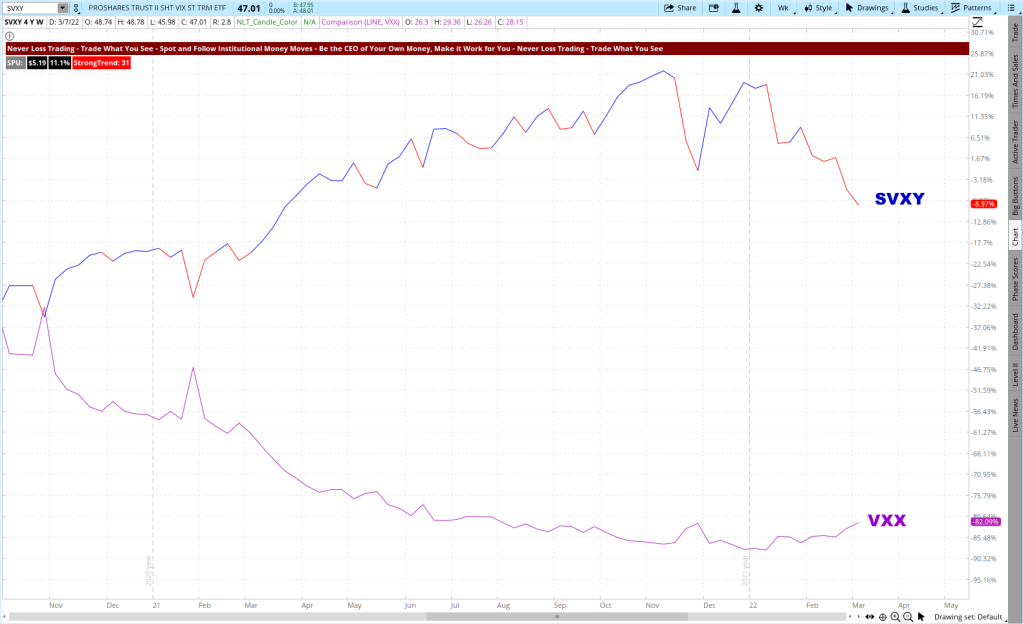Summary: Trading with expanding and contracting volatility offers an excellent opportunity for retail traders to operate with small risk units and strive for exceptional returns.
Volatility is a measure of price change over time. We take multiple volatility-related stats to determine the speed of price changes and the influence on the value of related assets.
Read on and watch the video!
The current market situation shows increased volatility levels that express a higher risk for long-term portfolio holders: We teach how to hedge your holdings in our mentorships. On the other hand, volatility swings offer great short-term trading opportunities if you are ready to identify crucial price turning points for solid returns; read on and experience that every market situation provides opportunities for those skilled and educated to participate.

A commonly known measure for volatility is the VIX Index, published by the CBOE. It measures the S&P 500 Index’s implied volatility based on options prices and judges the expectations for price fluctuations of the stock market. It is often called the “fear index”: at times of uncertainty, we have high VIX readings, suggesting that the stock market will be moving sharply either up or down, using percentage points. When the VIX prints at 30, It means that the market’s view on volatility is ±30% annualized, 68% of the time (standard deviation). The more expensive SPX options (insurances) become, the higher the VIX.
In general, the VIX is inversely related to the S&P 500 index: if the market goes down, the VIX goes up and vice versa.
Let us check a comparison of the VIX and the S&P 500 Index for the last three years:
S&P 500 Index and VIX Weekly, March 2019 to March 2022

By its nature, the VIX shows exceptional strong rises and contractions after, offering short-term traders opportunities to trade along with those price movements. Price changes resulted from a shift in supply and demand, and we developed NeverLossTrading Algorithms to forecast Volatility changes with high predictability. When prices radically change and show extreme fluctuations, we use the NLT Timeless Concept to dissect daily or weekly price changes into smaller, acceptable risk units. We best explain by some recent examples.
With the help of our indicators, you will no more see random price movements but patterns to follow at crucial price turning points: trade what you see – let the chart tell when to buy or sell!
The VIX index is not tradable for you as a private investor; however, you have multiple ways to trade the Volatility index as a retail trader. Here are the two we prefer:
- The Future: /VX requires about $10,000 of maintenance margin and a futures trading approval. If you want to follow the VIX development with this instrument, applicable price changes to trade for are about $1,000.
- An Exchange Traded Note (ETN) like VXX with a minimum risk unit of about $30 and an expected return on cash of 3% – 6% per day. There are other ETNs or ETFs; however, we prefer VXX over other alternatives based on volume and composition (contango, backwardation).
With the help of our charts and indicators, we will show examples of how you can follow predictable price changes. Our goal is to participate in expanding and contracting VXX developments. VXX shares are mostly rated ETB (easy to borrow); however, for shorting VXX, there are three prerequisites to consider: You need a broker that has shares of VXX available to borrow, a margin account, and sufficient cash or security holdings. Another way to short VXX is to buy SVXY. This Exchange Traded Fund goes up when VXX goes down. Buying an inverse fund does not require a margin account so that you can make this trade in ordinary cash accounts or IRAs. Please also consider that opening and closing more than three positions in a week makes you a pattern day trader, and you are required to hold $25,000 in your account (SEC regulation).
SVXY and VXX in Inverse Relation

The following chart gives you an overview of how our indicators spell out buying and selling opportunities. We will explain how to decide which indication to take and which not in the following. There are some rules to learn, and we will explain those further. By the much higher risk acceptance when trading the /VX future, we concentrate here on VXX charts in this publication.
By trading intraday or holding for a maximum of two days, topics like contango or backwardation are not considered when acting with VXX.
VXX on the NLT Timeless Chart

The chart shows volatility spikes and contraction after, allowing you to participate in the up da down moves of VXX.
Our indicators formulate price thresholds: Buy > and Sell <. This way, you can operate with buy-stop and sell-stop orders.
With our concept, we trade when VXX breaks out of the gray underlined boxes with an NLT Signal. And we disregard first opposite trades and favor seconds.
Some rules to learn, and we work with you in individual sessions and support you with specific documentation.
Let us go left to right and highlight potential trades and their outcome: A transaction comes to the target when the gray dot on the chart is reached, and we do not enter at the exit level. We cannot prevent an indicator from proposing buying or selling, but we teach you how to separate the good ones from those not in spec. Please watch the video for details!
VXX Day Trading on the NLT Timeless Chart (video)

Experience in a live session what we can do for you:
+1 866 455 4520 or contact@NeverLossTrading.com
Working one-on-one spots are extremely limited:
Do not miss out!
For more of our free publications and webinars…sign up here.
We are looking forward to hearing back from you.


No comments:
Post a Comment